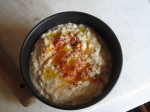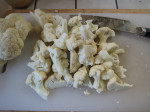Cauliflower Hummus
 This is a hummus where the cauliflower stands in for the chickpeas, so it is lighter both in texture and flavor. The garlic is blanched as well so the sweetness of the cauliflower stands out, but if you like, feel free to use raw garlic for a more assertive flavor. Using garlic roasted in its skin would enhance the sweet and nutty flavor of the cauliflower while backing off the heat and breath enhancing qualities of raw garlic. Use this where you would traditional hummus.
This is a hummus where the cauliflower stands in for the chickpeas, so it is lighter both in texture and flavor. The garlic is blanched as well so the sweetness of the cauliflower stands out, but if you like, feel free to use raw garlic for a more assertive flavor. Using garlic roasted in its skin would enhance the sweet and nutty flavor of the cauliflower while backing off the heat and breath enhancing qualities of raw garlic. Use this where you would traditional hummus.
INGREDIENTS:
4 cups cauliflower florets, cut into 1 inch bits 2 medium-smallish cloves garlic, peeled, or to taste
3-4 tablespoons tahini, or as needed
3-4 tablespoons lemon juice, Eureka preferred, although Meyer will work
½ teaspoon cumin seed, powdered
¼ teaspoon dried thyme, powdered
¼ teaspoon Pimenton de la Vera, or to taste (optional)
Salt and pepper to taste
¼ cup olive, or as needed
Water if needed
Za’atar for garnish
2 medium-smallish cloves garlic, peeled, or to taste
3-4 tablespoons tahini, or as needed
3-4 tablespoons lemon juice, Eureka preferred, although Meyer will work
½ teaspoon cumin seed, powdered
¼ teaspoon dried thyme, powdered
¼ teaspoon Pimenton de la Vera, or to taste (optional)
Salt and pepper to taste
¼ cup olive, or as needed
Water if needed
Za’atar for garnish
METHOD:
Split the garlic in half lengthwise and drop into boiling water until softened just enough that the tip of a sharp knife will easily pierce the side. Remove from the water and rinse to cool. Blot dry.
Steam or blanch the cauliflower until tender and just cooked all the way through. If there is still a little crunch to the florets that is fine, only a very little bit. Drain and rinse with cold water to halt the cooking process so the cauliflower does not turn too soft and mushy. Drain well.
Mince the garlic, then transfer it to the bowl of a food processor with 2 tablespoons olive oil. Process to puree.
Add the cauliflower, 3 tablespoons tahini and lemon juice, cumin,  thyme, and pimenton, and season with a little salt and pepper. Process for 15- 30 seconds to get an idea how much oil/and or water you might need to get things moving or to achieve the right consistency you want. You want to ingredients to move so they can puree, but you do not want to add so much oil the hummus is oily, nor do you want to add water if you can avoid so you do not dilute the flavor. If the vegetables are moving, add 1 tablespoon oil and puree until almost smooth, with chunky bits still showing. Taste for balance; do you taste the tahini? It should be in the foreground, but not enough to overwhelm the cauliflower. Enough acid to counter the olive oil and tahini? Is the flavor bright? If not, add a little more lemon juice. Add salt and pepper is needed, and the pimenton should just be a whisper of smoky sweet in the background. Make adjustments as needed, and then puree until it looks like hummus.
thyme, and pimenton, and season with a little salt and pepper. Process for 15- 30 seconds to get an idea how much oil/and or water you might need to get things moving or to achieve the right consistency you want. You want to ingredients to move so they can puree, but you do not want to add so much oil the hummus is oily, nor do you want to add water if you can avoid so you do not dilute the flavor. If the vegetables are moving, add 1 tablespoon oil and puree until almost smooth, with chunky bits still showing. Taste for balance; do you taste the tahini? It should be in the foreground, but not enough to overwhelm the cauliflower. Enough acid to counter the olive oil and tahini? Is the flavor bright? If not, add a little more lemon juice. Add salt and pepper is needed, and the pimenton should just be a whisper of smoky sweet in the background. Make adjustments as needed, and then puree until it looks like hummus.
To serve, transfer to a bowl and level the surface. Drizzle with a bright and pungent olive oil, the dust with a pinch of pimenton and scatter za’atar over the surface. Serve cold or cool. To store, keep in a closely covered vessel or with plastic wrap on the surface. Will keep 4-5 days before flavor drops off.
Chef’s Notes:
Whatever you do, avoid over-cooking the cauliflower. Doing so will result in a mushy texture and a swampy bitter flavor. Using raw garlic will give a more traditional tasting hummus, and using roasted garlic adds a mellow sweetness with a little smoky quality added. Some recipes use nut butters to thicken the hummus, but I like the lower calories and the subtler cauliflower flavor of this iteration.
Yield: 3-4 cups
Source: Chef Andrew E Cohen
Search High Ground Site
High Ground Favorites Cloud
apples arugula basil beets braise broccoli carrots cauliflower celery chard cheese cilantro dressing fennel fish herbs kale leeks lemon lettuce Meyer lemon mint mushrooms nuts onions oregano parsley peppers pork potatoes quickles radishes salad sauce saute scallions soup strawberries summer squash tomatoes topping vegan vegetarian vinaigrette winter squash


